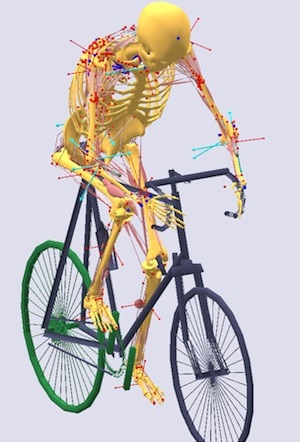Check it Out: Simulate Biomechanical Systems
Latest News
December 4, 2001
By Anthony J. Lockwood
Dear Desktop Engineering Reader:
 Think of a yourself driving a car. You’re a biomechanical system. Parametrize yourself for simulation: posture, the weight of each arm and leg, the seat incline, force feedback from the pedals, and other forces and conditions influencing one another. To model your body/environment system—say, hitting the brakes—you need to couple disciplines like kinematics, nonlinear dynamics, and structural analysis. That means mind-boggling variables and lots of physics. This is one reason why biomechanical simulation is among the last toolsets missing in the CAE toolkit.
Think of a yourself driving a car. You’re a biomechanical system. Parametrize yourself for simulation: posture, the weight of each arm and leg, the seat incline, force feedback from the pedals, and other forces and conditions influencing one another. To model your body/environment system—say, hitting the brakes—you need to couple disciplines like kinematics, nonlinear dynamics, and structural analysis. That means mind-boggling variables and lots of physics. This is one reason why biomechanical simulation is among the last toolsets missing in the CAE toolkit.
Still, some biomechanical simulation tools live in academia and a handful of commercial offerings exist. I’ve recently been checking out AnyBody Technology, a Danish developer of a commercial biomechanical simulation system called the AnyBody Modeling System. They hooked me on this fascinating area of CAE in two ways quickly: one, AnyBody runs on ordinary engineering workstations and two, it seems relatively easy to use.
So what is AnyBody? Well, it’s a musculoskeletal modeler that simulates and calculates the mechanical properties of a body/environment system. Ergonomics, you say. Well, ergonomics can embrace biomechanics for sure. But it’s more making an environment, say desks or office morale, suitable for humans. Biomechanics is the mechanical engineering of your body manipulating the world—powering a wheelchair, exiting a car, schlepping a factory cart, and so on.
AnyBody produces simulation results for such body movements as individual muscle forces, joint forces and moments, metabolism, elastic energy in tendons, and antagonistic muscle actions. It leverages a continually updated collection of detailed, scalable anthropomorphic models performing different activities. Or AnyBody can use your motion studies, parameters from your data, and even your estimates of external forces, boundary conditions, and posture to simulate your biomechanical system. Results are exportable to finite element modelers like Abaqus or ANSYS, meaning that you can analyze the material stresses and strains a load causes tissues and inserted devices.
AnyBody body models offer more than 1,000 individually activated muscles. A key part of the models, especially for you in orthopedic device manufacturing, is that they are validated from published data rather than representative of the developer’s best guess. And, a company spokesperson tells me, new methods that can model specific individuals are rolling out.
You can check out more about AnyBody from this link. The link sends you to the AnyBody Technology website. Wander around and become fascinated as did I. You’ll find details on what AnyBody could mean for orthopedics, automotive, occupational health, and other areas of engineering concern. There are videos and animated gifs as well. Make sure to take in a webinar or two.
The human body moving in the world is a highly complex, multidisciplinary engineering challenge, a challenge that has defied the limits of simulation. The AnyBody Modeling System is intended to produce reliable simulation results on an engineering workstation of you and I interacting with the physical world. That alone certainly makes it worth checking it out.Thanks, Pal. — Lockwood
Anthony J. Lockwood
Editor at Large, Desktop Engineering
Subscribe to our FREE magazine, FREE email newsletters or both!
Latest News
About the Author
Anthony J. Lockwood is Digital Engineering’s founding editor. He is now retired. Contact him via [email protected].
Follow DE





